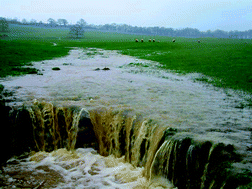This paper quantifies the yields of suspended solids (SS) from a headwater catchment managed as improved temperate grassland, providing the first direct, catchment-scale evidence of the rates of erosion from this land-use in the UK and assessing the threat posed to aquatic ecosystems. High-resolution monitoring of catchment hydrology and the concentrations of SS and volatile organic matter (VOM) were carried out in the first-order channel of the Den Brook headwater catchment in Devon (UK) during the 2006–2007 hydrological season. The widely used ‘rating curve’ (discharge-concentration) approach was employed to estimate yields of SS, but as demonstrated by previous researchers, this study showed that discharge is a poor predictor of SS concentrations and therefore any yields estimated from this technique are likely to be highly uncertain. Nevertheless, for the purpose of providing estimates of yields that are comparable to previous studies on other land uses/sources, this technique was adopted albeit in an uncertainty-based framework. The findings suggest that contrary to the common perception, grasslands can be erosive landscapes with SS yields from this catchment estimated to be between 0.54 and 1.21 t ha−1 y−1. In terms of on-site erosion problems, this rate of erosion does not significantly exceed the commonly used ‘tolerable’ threshold in the UK (∼1 t ha−1 y−1). In terms of off-site erosion problems, it is argued here that the conventional expression of SS yield as a bulk annual figure has little relevance to the water quality and ecological status of surface waters and therefore an alternative technique (the concentration–frequency curve) is developed within this paper for the specific purpose of assessing the ecological threat posed by the delivery of SS into surface waters. This technique illustrates that concentrations of SS recorded at the catchment outlet frequently exceed the water quality guidelines, such as those of the EU Freshwater Fisheries Directive (78/659/EC), and pose a serious threat to aquatic organisms. It is suggested that failure to recognise improved temperate grasslands as a potential source of particulate material could result in the non-compliance of surface waters to water quality guidelines, deterioration of ecological status and failure of water quality remediation measures.

You have access to this article
 Please wait while we load your content...
Something went wrong. Try again?
Please wait while we load your content...
Something went wrong. Try again?


 Please wait while we load your content...
Please wait while we load your content...